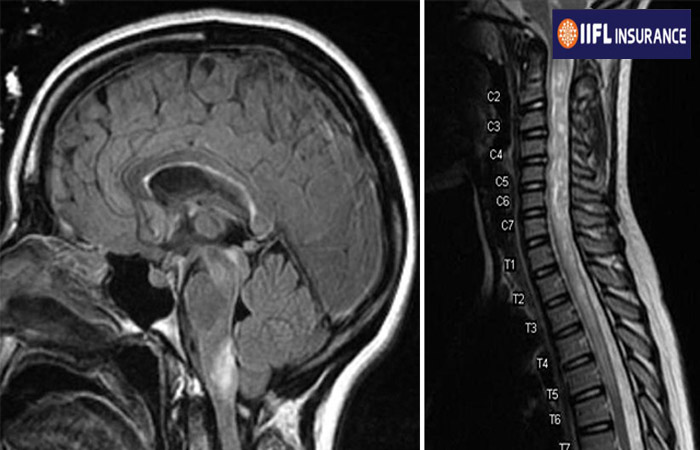Neuromyelitis Optica (NMO) or Devic's disease is a rare condition where your immune system attacks and damages the spinal cord and optic nerves. Though primarily this disease attacks your optic nerves and spinal cord, sometimes it may affect your brain. This disease is more common in women than men.
Causes of Neuromyelitis Optica Spectrum Disorder
This is an autoimmune disease where your body’s immune system reacts strangely and attacks wholesome tissues. Though this is not inherited, some people with NMO may have a family history of autoimmune disorders.Neuromyelitis Optica Symptoms
The symptoms of this disease are not the same for all, each person will experience different symptoms. The symptoms can be:- Eye pain
- Loss of vision
- Colors appearing not prominent or less vivid
- Feebleness in the arms and legs
- Pain (sharp, burning, shooting, or numbing) in the arms or legs increased sensitivity to cold and heat
- Tight and aching muscle spasms in the arms and legs
- Vomiting
- Bladder, bowel, and sexual problems
- Sometimes, the spinal cord becomes inflamed and irritated. This situation is called transverse myelitis.
- The optic nerve (from the eye to the brain) may also become inflamed, and this condition is called optic neuritis.
Neuromyelitis Optica Treatment
1. Treatment for a Flare-Up
Most people experience flare-ups or outbreaks, then the recovery period lasts for months or years. Various parts of your body get damaged due to these attacks. So, the prime aim of the treatment is to stop and prevent these attacks. Though sometimes the damage is permanent, treatment will prevent or reverse your symptoms.To stop outbreaks, your doctor will use
- IV steroids: Your doctor will prescribe a steroid (IV methylprednisolone) to soothe your immune system. This is an intravenous injection that will be given for a few days, at a hospital or infusion center. The duration of each treatment is 1-3 hours.
- Changes in blood pressure
- Fast heart rate
- Sweating or flushing
- Stomach upset
- Heartburn
- Metallic taste
- Enhanced appetite
- Swollen ankles
- Trouble sleeping
- Mood changes
- Elevated blood sugar
- Plasmapheresis, or plasma exchange
A healthcare expert will,
- Insert a needle with thin tubing into your vein (mainly in your arm)
- Collect some of your blood
- By using a machine, he/she will separate your blood cells and plasma
- The machine then binds up with an artificial plasma substitute for your blood cells.
- Your healthcare expert will return the blood to your body through another vein.
- Several hours are needed for plasma exchange every other day, for about 2 weeks.
2. Long-Term Treatment
NMO attacks are recurrent this means they may come back after several years from your first attack. To avert this, your doctor will prescribe some medications that you need to take.- Immune Suppressants: These types of drugs usually soothe your immune system.
Though immune suppressants are effective, they have some side effects and costs also. So, talk to your doctor regarding the side effects of each medicine. Some may not be useful in pregnancy, for example. If you are pregnant or planning to become pregnant, tell your doctor.
Top 6 Immunosuppressive Medications
- Azathioprine (Azasan, Imuran): You need to take this medicine twice a day. You may experience some stomach upsets like bloating, constipation, nausea, or diarrhea. It may also irritate your liver. Your doctor will recommend some tests occasionally to check the parameters.
- Mycophenolate mofetil (CellCept): This daily medication also has some side effects that are similar to azathioprine. This may also affect your liver. You may experience headaches while starting the medication.
- Rituximab (Rituxan, Ruxience, Truxima): You will get IV treatments twice a year in an infusion center or hospital. The side effects are fewer. The FDA has approved two medications to control the symptoms of NMO. People who have NMO may possess an antibody called anti-aquaporin-4, or AQP4. If your blood test indicates that you have AQP4, your doctor will recommend one of these treatments.
- Eculizumab (Soliris): You get an IV infusion once a week for 5 weeks. After that, you need to continue your treatment every 2 weeks. Eculizumab uplifts your risk for meningococcal infections, a lethal condition that damages your brain and spinal cord. Get vaccinated for these infections before plunging into the treatment. Side effects of eculizumab may be nose and throat infections, headache, back pain, and nausea.
- Inebilizumab (Uplizna): within 2 weeks apart, you will receive your first two doses of this IV medication. Then you will receive it twice yearly. The most common side effects can be urinary tract infections and joint pain.
- Natalizumab-mwge (Enspryng): This medication is applied as a shot two and four weeks after the first shot and then every four weeks after. Common side effects are headaches, nausea, tiredness, and pain in the extremities.


